上一篇整合redis框架作为mybatis的二级缓存, 该篇从源码角度去分析mybatis是如何做到的。
通过上一篇文章知道,整合redis时需要在FemaleMapper.xml中添加如下配置
<cache eviction="LRU" type="qinfeng.zheng.RedisCache"/>
MYBATIS源码分析之02配置文件解析 这篇文章讲解了mybatis解析配置文件具体的过程。
这里再总结一下,mybatis解析主配置文件使用了XMLConfigBuilder对象;解析具体的Mapper接口配置则使用了XMLMapperBuilder对象,是不是很好记忆。。。
所以,要了解mybatis是如何是解析 <cache eviction="LRU" type="qinfeng.zheng.RedisCache"/> 这行代码 ,肯定得去XMLMapperBuilder这个类了,
具体看XMLMapperBuilder#configurationElement(XNode context)方法。
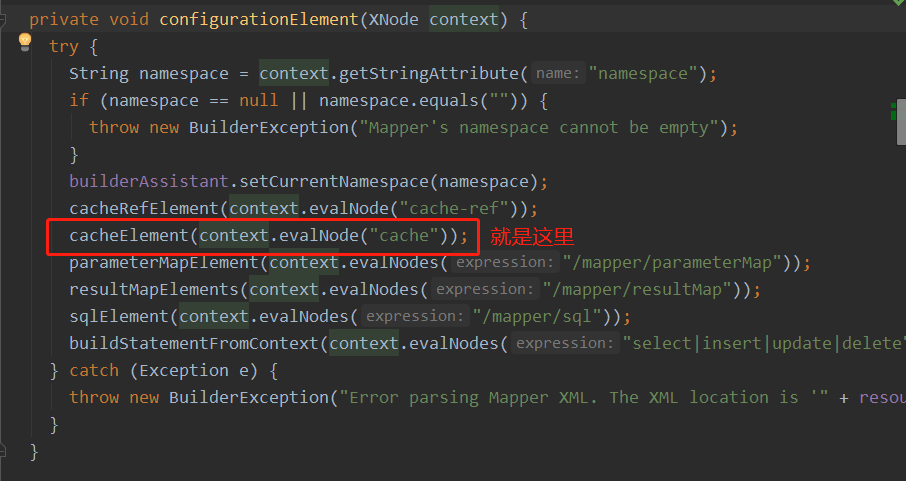
很明显,具体的实现在cacheElement()方法中, 结合debug看一下

接着我们可以再深究一下builderAssistant是如何创建这个缓存的。
public Cache useNewCache(Class<? extends Cache> typeClass, Class<? extends Cache> evictionClass, Long flushInterval, Integer size, boolean readWrite, boolean blocking, Properties props) { Cache cache = new CacheBuilder(currentNamespace) .implementation(valueOrDefault(typeClass, PerpetualCache.class)) .addDecorator(valueOrDefault(evictionClass, LruCache.class)) .clearInterval(flushInterval) .size(size) .readWrite(readWrite) .blocking(blocking) .properties(props) .build(); configuration.addCache(cache); currentCache = cache; return cache; }
由上面的这段代码知道 ,mybatis框架使用了一个构建者模式去创建一个Cache对象。 对于复杂对象的创建,我认为使用构建者模式是很有必要的,代码起来也很会舒服!
我们看看build()方法中,具体是如何构造这个Cache对象的。
public Cache build() { setDefaultImplementations(); // 使用反射创建了一个Cache对象(真实类型就是我们的RedisCache) Cache cache = newBaseCacheInstance(implementation, id); setCacheProperties(cache); // issue #352, do not apply decorators to custom caches if (PerpetualCache.class.equals(cache.getClass())) { for (Class<? extends Cache> decorator : decorators) { cache = newCacheDecoratorInstance(decorator, cache); setCacheProperties(cache); } cache = setStandardDecorators(cache); } else if (!LoggingCache.class.isAssignableFrom(cache.getClass())) { cache = new LoggingCache(cache); } return cache; }
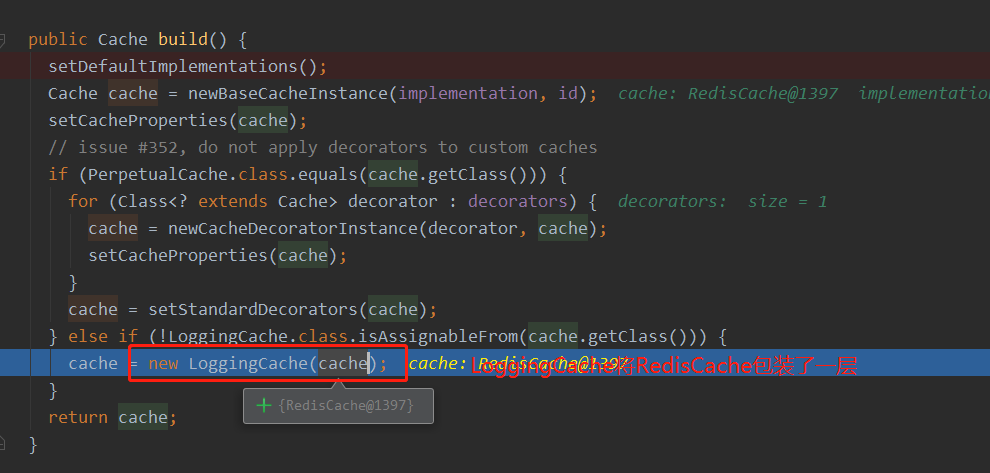

至此,应该已经说明了mybatis是如何解析二级缓存的配置的了!
***************************************************************************************************************
以下内容,我们看看mybatis是如何使用二级缓存的。
在说mybatis的一级缓存时,提到了二级缓存,就是CachingExecutor#query()方法,具体见下面这段代码
public <E> List<E> query(MappedStatement ms, Object parameterObject, RowBounds rowBounds, ResultHandler resultHandler,
CacheKey key, BoundSql boundSql) throws SQLException { Cache cache = ms.getCache(); if (cache != null) { flushCacheIfRequired(ms); if (ms.isUseCache() && resultHandler == null) { ensureNoOutParams(ms, boundSql); @SuppressWarnings("unchecked") List<E> list = (List<E>) tcm.getObject(cache, key); if (list == null) { list = delegate.query(ms, parameterObject, rowBounds, resultHandler, key, boundSql); tcm.putObject(cache, key, list); // issue #578 and #116 } return list; } } return delegate.query(ms, parameterObject, rowBounds, resultHandler, key, boundSql); }
咱们还是debug分析
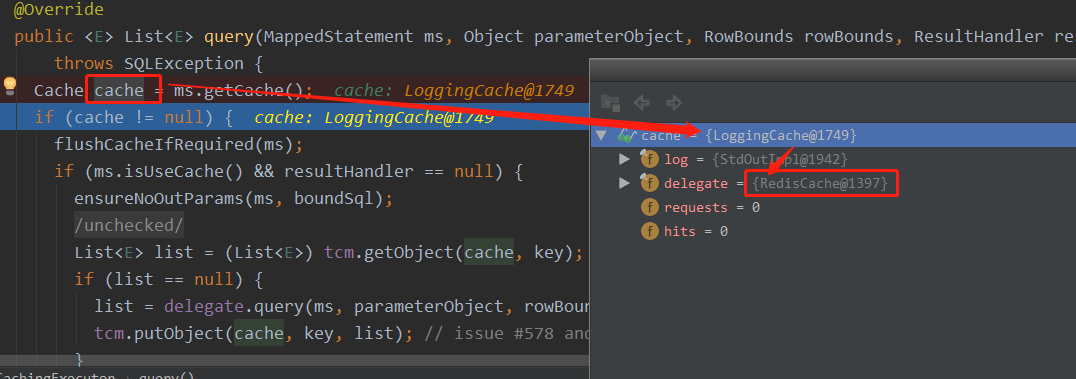
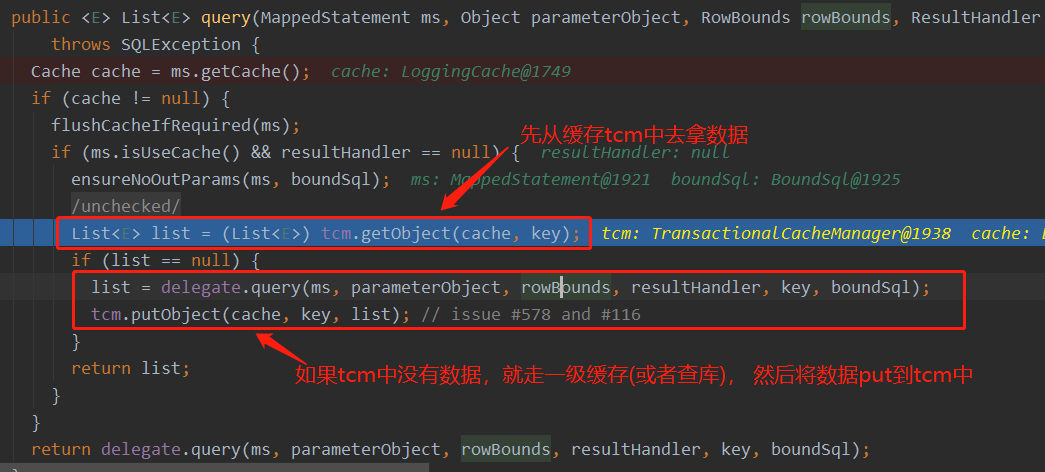
哈哈,这个tcm就跟二级缓存密切相关了,我们需要细读, 从getObject(cache,key)方法开始,我们会进入到TransactionalCache#getObject(Object key)方法。
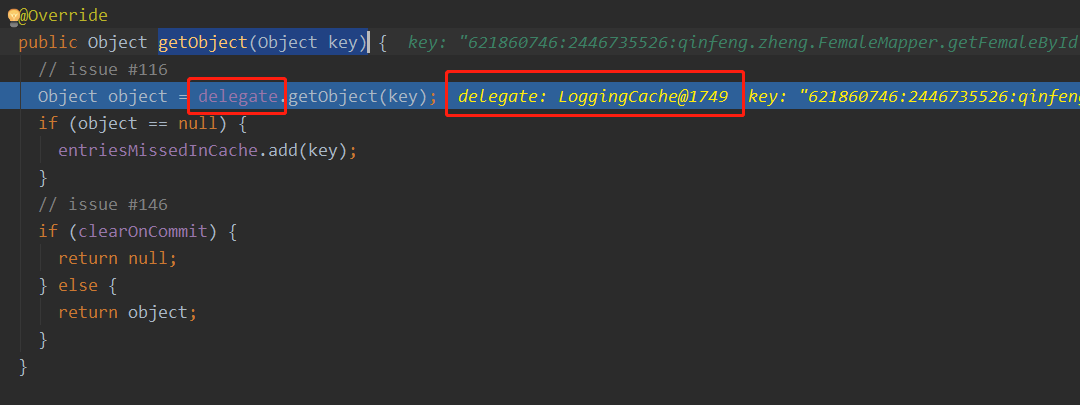
F7再进入到LoggingCache#getObject(key)
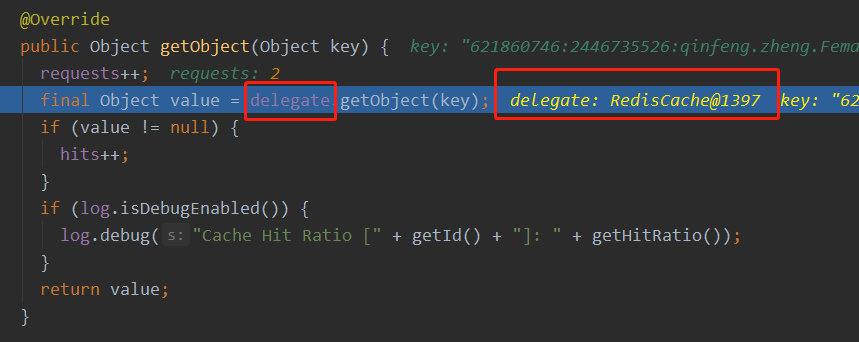
哈哈,这里的delegate就是RedisCache了,getObject(key)就会调用我们自定义的逻辑了,也就是下面这段代码,从redis中去拿数据
@Override public Object getObject(Object key) { return execute(jedis -> { try { byte[] bytes = jedis.hget(id.getBytes(), key.toString().getBytes()); if (bytes == null) { return null; } ByteArrayInputStream inputStream = new ByteArrayInputStream(bytes); ObjectInputStream objectInputStream = new ObjectInputStream(inputStream); return objectInputStream.readObject(); } catch (Exception e) { throw new RuntimeException("get data from redis error!", e); } }); }
至此,从二级缓存中getObject已经说完了,下面说下putObject, 我们还是从TransactionalCache#putObject(key,value)说起。 大家可以知道 ,mybatis的二级缓存与TransactionalCache脱离不了关系,mybatis的一级缓存与PerpetualCache 脱离不了关系。
好,言归正传,继续看TransactionalCache#putObject(key,value)方法
@Override public void putObject(Object key, Object object) { entriesToAddOnCommit.put(key, object); }
大家可以看到,putObject方法只是将数据put到entriesToAddOnCommit这个Map集合中,并没有真定写入到redis中。
上篇已经说了,mybatis框架是在commit()时,将entriesToAddOnCommit中的数据写入到redis中, 我们可以简单看一下源码。
public void commit() { if (clearOnCommit) { delegate.clear(); } flushPendingEntries(); reset(); }
private void flushPendingEntries() { for (Map.Entry<Object, Object> entry : entriesToAddOnCommit.entrySet()) { delegate.putObject(entry.getKey(), entry.getValue()); } for (Object entry : entriesMissedInCache) { if (!entriesToAddOnCommit.containsKey(entry)) { delegate.putObject(entry, null); } } }


好,完了,下面总结一下!
总结;
(1) 如果MappedStatement中没有二级缓存,直接走一级缓存
(2) 如果MappedStatement中有二级缓存,则从二级缓存中查询数据
(3) 如果二级缓存中没有查询到数据,则走一级缓存(一级没有,就查库), 并且将从一级缓存中获取到的数据写入到TransactionalCache#entriesToAddOnCommit集合中,缓存起来
(4) 调用SqlSession#commit()方法时,会将TransactionalCache#entriesToAddOnCommit集合中缓存起来的数据写入到二级缓存中